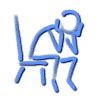
The provision of a separate section for disorders that are usually first diagnosed in infancy, childhood, or adolescence is for convenience only and is not meant to suggest that there is any clear distinction between “childhood” and “adult” disorders. Although most individuals with these disorders present for clinical attention during childhood or adolecence, the disorders sometimes are not diagnosed until adulthood. Moreover, many disorders including in other sections of the manual often have an onset during childhood or adolescence. (p. 37)
Mental Retardation This disorder is characterized by significantly subaverage intellectual functioning (an IQ of approximately 70 or below) with onset before age 18 years and concurrent deficits or impairments in adaptive function. Separate codes are provided for Mild, Moderate, Severe, and Profound Mental retardation and for Mental Retardation, Severity Unspecified.
Learning Disorders. These disorders are characterized by academic functioning that is substantially below that expected given the person’s chronological age, measured intelligence, and age-appropriate education. The specific disorders include in the section are Reading Disorder, Mathematics Disorder, Disorder of Written Expression, and Learning Disorder Not Otherwise Specified.
Motor Skills Disorder. This includes Developmental Coordination Disorder,
which is characterized by motor coordination that is substantially below that expected given the person’s chronological age and measured intelligence.
Communication Disorders. These disorders are characterized by difficulties in speech or language and include Expressive Language Disorder, Mixed Receptive-Expressive Language Disorder, Phonological Disorder, Stuttering and
Communication Disorder Not Otherwise Specified.
Pervasive Developmental Disorders. These disorders are characterized by severe deficits and pervasive impairment in multiple areas of development. These include impairment in reciprocal social interaction, impairment in communication, and the presence of stereotyped behavior, interests, and activities. The specific disorders included in this section are
Autistic Disorder, Rett’s Disorder, Childhood Disintegrative Disorder, Asperger’s Disorder, and Pervasive Developmental Disorder Not Otherwise Specified.
Attention-Deficit and Disruptive Behavior Disorders. This section includes
Attention-Deficit/Hyperactivity Disorder, which is characterized by prominent symptoms of inattention and/or hyperactivity-impulsivity. Subtypes are provided for specifying the predominant symptom presentation:
Predominantly Inattentive Type, Predominantly Hyperactive-Impulsive Type,
and Combined Type. Also included in this section are the Disruptive Behavior Disorders: Conduct Disorder is characterized by a pattern of behavior that violates the basic rights of others or major age-appropriate societal norms or rules; Oppositional Defiant Disorder
is characterized by a pattern of negativistic, hostile, and defiant behavior. This section also includes two Not Otherwise Specified categories:
Attention-Deficit/Hyperactivity Disorder Not Otherwise Specified
and Disruptive Behavior Disorder Not Otherwise Specified.
Feeding and Eating Disorders of Infancy or Early Childhood. These disorders are characterized by persistent disturbances in feeding and eating. The specific disorders included are Pica, Rumination Disorder, and
Feeding Disorder of Infancy or Early Childhood. Note that Anorexia Nervosa and Bulimia Nervosa are included in the “Eating Disorders” section presented later in the manual (see p. 539).
Tic Disorders. These disorders are characterized by vocal and/or motor tics. The specific disorders included are Tourette’s Disorder, Chronic Motor or Vocal Tic Disorder, Transient Tic Disorder, and Tic Disorder Not Otherwise Specified.
Elimination Disorders. This grouping includes Encopresis, the repeated passage of feces into inappropriate places, and Enuresis, the repeated voiding of urine into inappropriate places.
Other Disorders of Infancy, Childhood, or Adolescence . This grouping is for disorders that are not covered in the sections listed above.
Separation Anxiety Disorder is characterized by developmentally inappropriate and excessive anxiety concerning separation from home or from those to whom the child is attached. Selective Mutism
is characterized by a consistent failure to speak in specific social situations despite speaking in other situations.
Reactive Attachment Disorder of Infancy or Early Childhood is characterized by markedly disturbed and developmentally inappropriate social relatedness that occurs in most contexts and is associated with grossly pathogenic care. Stereotypic Movement Disorder is characterized by repetitive, seemingly driven, and nonfunctional motor behavior that markedly interferes with normal activities and at times may result in bodily injury.
Disorder of Infancy, Childhood, or Adolescent Not Otherwise Specified is a residual category for coding disorders with onset in infancy, childhood, or adolescence that do not meet criteria for any specific disorder in the Classification. (p. 37-9)

|
|


|

|
